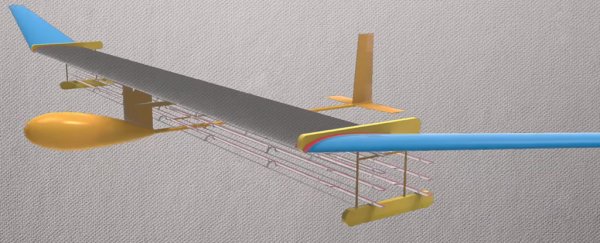A set of wings with wires for engines has established a landmark in aviation, becoming the first object to breeze through the air on the cusp of its own, self-generated ionic wind.
At first glance, it looks like the kind of aircraft even the pioneering Wright brothers would have rejected as too ludicrous to fly.
But the MIT engineers who designed and built the device did so to test the feasibility of a propulsion system based on the thrust generated by charged particles pushing against a fluid.
This isn't to be confused with other promising (or not so promising) solid-state engines that use electromagnetism to generate thrust in a vacuum.
Electroaerodynamics (EAD) is a far simpler concept, in principle. Electrons and charged molecules, or ions, are generated in such a way they can be used to produce a practical amount of thrust in an atmosphere.
This is achieved through a phenomenon called a corona discharge, where ions surrounding an electrode give rise to a cascade effect, as showers of electrons strip other electrons from surrounding molecules in the atmosphere, just shy of generating a spark.
The drifting of ionised air molecules surrounding that perpetually unborn spark can theoretically create thrust.
In plain old Newtonian physics, such a 'charged wind' would perform much the same job as the air swept back by a moving propeller, or the heated gases escaping a turbine engine.
It's one of those 'nice idea… in theory' concepts. To be useful as an engine, sufficient thrust would need to be generated to keep a mass airborne. And for decades, the evidence said this just isn't going to happen.
A practical approach was proposed along with some early experimentation in the 1960s, and considered to be too inefficient to ever be more than a novelty in practice. NASA gave it a whirl about ten years ago, concluding "the use of a corona discharge for aircraft propulsion did not seem very practical."
Disheartening as the results were, they don't exactly spell 'impossible'. Enough wiggle room has remained for researchers to wonder if practical was simply a matter of finding the right design and materials.
So MIT engineers used a technique called geometric programming to fine tune the optimal design and power requirements, finding a model that more than doubled previously predicted efficiencies.
Numerous fine wires the engineers called emitters serve as the craft's drivers, delivering at least 20,000 volts of electrical potential to give rise to just the right about of corona discharge get airborne.
The resulting model looks more like a throwback to the early days of heavier-than-air flying machines. And, frankly, it performs much like one as well.
It barely weighs 2.5 kilograms (5.5 pounds). Even if its ultralight frame could carry so much as an empty briefcase, it still wouldn't lift you across the parking lot, let alone across the Atlantic. None of its 10 journeys flew more than 60 metres (200 feet).
But the fact it was nudged gently through the air by a wind arising from its own electrostatic forces at a speed of around 4.8 metres (16 feet) per second makes its development a monumental step forward.
Better yet, the results indicate performance would only increase with velocity. As it speeds up, it consumes relatively less energy. At a velocity of about 300 metres (980 feet) per second, a craft could be as much as 50 percent more efficient.
As the 'engines' are little more than fine wires, adding more wouldn't incur a cost of more drag. That means the concept could be scaled up.
Part of the appeal of succeeding is that engines based on EAD technology are solid state. That means they wouldn't require a drop of combustible fuel or a single rotating cog, resulting in a relatively noiseless flight sustained only by the whisper of electricity through a circuit.
Listen to Stephen Barret from MIT's Department of Aeronautics and Astronautics explain the appeal of their work below.
We're still nowhere near silent airbuses ferrying us from New York to Beijing on a mesh of electrified wires. Sorry. While the tech can scale easily, there's still no evidence suggesting it could be ramped up to take on a truly heavy load.
But we just might be on our way to simple, lightweight devices that tirelessly skim the skies without a need to refuel or repair. Or swarms of drones that flit through the suburbs without raising a racket.
With a proof of concept in our hands, no doubt we'll be seeing plenty of experimentation in the near future.
And hopefully a renaissance of those whacky, old fashioned flying machines.
This research was published in Nature.
